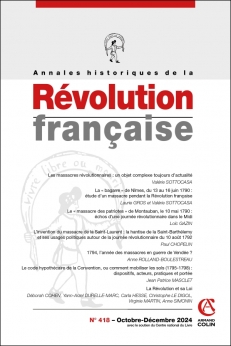
ANNALES HISTORIQUES DE LA RÉVOLUTION FRANÇAISE Nº418 (4/2024)
Pour acheter ce numéro, contactez-nous
Recevez les numéros de l'année en cours et accédez à l'intégralité des articles en ligne.
Dans la seconde moitié du XVIIIe siècle, à travers notamment les écrits de Voltaire, le Massacre de la Saint-Barthélemy devient le symbole du dévoiement de l’autorité royale sous l’effet du fanatisme. Le nouveau conflit religieux qui se dessine à la fin des années 1780 autour de la tolérance du protestantisme avive le traumatisme mémoriel. La peur d’une « Saint-Barthélemy des patriotes » commence à se manifester dès l’été 1789, avant que le succès théâtral du Charles IX de Chénier, l’année suivante, n’informe l’imaginaire de ceux qui craignent un soulèvement fanatique orchestré par le clergé réfractaire. À Paris, en 1791-1792, la hantise de la Saint-Barthélemy alimente peurs et rumeurs autour d’un grand massacre en préparation, dont Louis XVI et Marie-Antoinette, nouveau Charles IX et nouvelle Catherine de Médicis, seraient les ordonnateurs. Cette hantise joue un rôle moteur dans le déclenchement de l’insurrection du 10 août 1792, justifiée par certains comme un acte de légitime défense, à la veille d’une nouvelle Saint-Barthélemy : le Massacre de la Saint-Laurent.
In the second half of the eighteenth century, in the writings of Voltaire in particular, the St. Bartholomew’s Day Massacre became a symbol of the way in which royal authority had been adversely affected by fanaticism. The new religious conflict that took shape at the end of the 1780s over the issue of the toleration of Protestantism revived traumatic memories. The fear of a “St. Bartholomew’s Day of the Patriots” began to emerge in the summer of 1789, before the theatrical success of Chénier’s play Charles IX in the following year that would further inflame the imaginations among those who feared a fanatical uprising orchestrated by the refractory clergy. In Paris in 1791-1792 the horror of another St. Bartholomew’s Day fueled fears and rumors of a great massacre in the making, organized by Louis XVI and Marie-Antoinette, the new Charles IX and Catherine de Médicis. This fear played a major role in triggering the insurrection of August 10, 1792, justified by some as a legitimate act of self-defense on the eve of another St. Bartholomew’s Day Massacre.